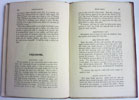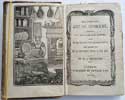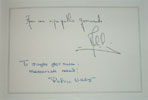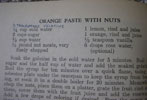The Epicurean.
A COMPLETE TREATISE OF ANALYTICAL AND PRACTICAL STUDIES ON THE CULINARY ART INCLUSING Table and Wine Service, How to Prepare and Cook Dishes, and Index for Marketing, a Great Variety of Bills of Fare for Breakfasts, Luncheons, Dinners, Suppers, Ambigus,. Buffets, etc., and a Selection of Interesting Bills of Fare of Delmonico's. From 1862 to 1894. MAKING A FRANCO-AMERICAN CULINARY ENCYCLOPEDIA By CHARLES RANHOFER, FORMER CHEF OF DELMONICO'S, Honorary President of the "Societe Culinaire Philanthropique" of New York. (single straight line) ILLUSTRATED WITH 800 PLATES. (single straight line underneath). JOHN WILLY, PUBLISHER 443 SOUTH DEARBORN STREET CHICAGO, ILLINOIS, U.S.A.
Copyright 1920. 280 x 210 mm x 90 mm thick. Original paper design in front paste down and fep. 2 extra feps. Frontispiece of Charles Ranhofer with elaborate design and Ranhofer’s facsimile signature. Wonderful ornate etched extra title page with tissue guard. [1] 2nd Title page. [1] (1)viii Preface. Facsimile Delmonico’s letter signed by Ranhofer dated Feby [sic] 24th 1893. [1] 1 page Contents with etching of Table service on verso. 1page Table service. [1] (1)2-1137. 1page Additional Recipes. (1)1140-1183 Index. [1] Original paper design in back paste down and last fep. 800 plates in-text. Original dark brown boards and spine with Art Deco embossed design on front cover and spine. In fantastic clean original state.
- Charles Ranhofer, born November 7, 1836 in Saint-Denis, France, died October 9, 1899 in New York. He was the famous Chef at the equally famous Delmonico's Restaurant in New York from 1862 to 1876 and 1879 to 1896. Author of The Epicurean, first edition 1894, a massive compendium of menus, techniques, terminology and recipes, written after his retirement. Similar in scope to Escoffier's Le Guide Culinaire, but with the plates and in-text etchings, closer in style to Urbain Dubois’ monumental works. Ranhofer was sent to Paris at the age of 12 to begin his training as a commis Patissiere, and unbelievably, at 16, became the private Chef for the Prince d'Hénin comte d'Alsace. In 1856 he moved to New York to become the Chef to the Russian consul, and later worked in Washington, D.C. and New Orleans. He returned to France in 1860 for a short time, where he arranged balls for the court of Napoleon III at the Tuileries Palace, but then came back to New York to work at what was then a fashionable location; Maison Dorée. In 1862, Lorenzo Delmonico hired him for Delmonico's, and it was there that Ranhofer achieved real fame, and made the world-renowned reputation of the restaurant as well. At that time, Delmonico's was considered the finest restaurant in the United States and abroad. He was the Chef de Cuisine at Delmonico's until his retirement in 1896, except for a short hiatus from 1876 and 1879 when he owned the "Hotel American" at Enghien-les-Bains, a commune in the northern suburbs of Paris. Ranhofer is credited with inventing or making famous a number of dishes that Delmonico's was known for, such as Lobster Newberg. Named in honour of sea captain Ben Wenberg, but then renamed, when Wenberg had a falling-out with the Restaurant. He had, like Escoffier, a talent for naming dishes after famous or prominent people, particularly guests of Delmonico's. He also experimented with new foods, one of which he acquainted New Yorker's with, was the "alligator pear" (avocado) in 1895. Ranhofer's creativity and pursuit of excellence had very few peers in the history of haute cuisine. Delmonico’s boasted a guest list that included Charles Louis Napoleon, Oscar Wilde, Charles Dickens, Queen Victoria, Walter Scott and Lillian Russell, amongst many others, drawn to its reputation for fine food and it’s famous Chef. Ranhofer and his wife Rose had five children: three sons and two daughters. He died at home of Bright's Disease and was buried at Woodlawn Cemetery, in the Bronx NY.






click on image to enlarge

Modern category
ref number:
11237 















































